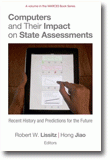
Computers and Their Impact on State Assessments
Recent History and Predictions for the Future
Edited by:
Robert W. Lissitz, University of Maryland
Hong Jiao, University of Maryland
A volume in the series: The MARCES Book Series. Editor(s): Hong Jiao, University of Maryland. Robert W. Lissitz, University of Maryland.
Published 2012
The Race To The Top program strongly advocates the use of computer technology in assessments. It dramatically promotes computer-based testing, linear or adaptive, in K-12 state assessment programs. Moreover, assessment requirements driven by this federal initiative exponentially increase the complexity in assessment design and test development. This book provides readers with a review of the history and basics of computer-based tests. It also offers a macro perspective for designing such assessment systems in the K-12 setting as well as a micro perspective on new challenges such as innovative items, scoring of such items, cognitive diagnosis, and vertical scaling for growth modeling and value added approaches to assessment. The editors’ goal is to provide readers with necessary information to create a smarter computer-based testing system by following the advice and experience of experts from education as well as other industries.
This book is based on a conference (http://marces.org/workshop.htm) held by the Maryland Assessment Research Center for Education Success. It presents multiple perspectives including test vendors and state departments of education, in designing and implementing a computer-based test in the K-12 setting. The design and implementation of such a system requires deliberate planning and thorough considerations. The advice and experiences presented in this book serve as a guide to practitioners and as a good source of information for quality control.
The technical issues discussed in this book are relatively new and unique to K-12 large-scale computer-based testing programs, especially due to the recent federal policy. Several chapters provide possible solutions to psychometricians dealing with the technical challenges related to innovative items, cognitive diagnosis, and growth modeling in computer-based linear or adaptive tests in the K-12 setting.
CONTENTS
Preface. Computer-Based Testing in K–12 State Assessments, Hong Jiao and Robert W. Lissitz. PART I: COMPUTER-BASED TESTING AND ITS IMPLEMENTATION IN STATE ASSESSMENTS. History, Current Practice, Perspectives and what the Future Holds for Computer Based Assessment in K–12 Education, John Poggio and Linette McJunkin. A State Perspective on Enhancing Assessment and Accountability Systems through Systematic Implementation of Technology, Vincent Dean and Joseph Martineau. What States Need to Consider in Transitioning to Computer-Based Assessments from the Viewpoint of a Contractor, Walter D. Way and Robert K. Kirkpatrick. Operational CBT Implementation Issues: Making It Happen, Richard M. Luecht. PART II: TECHNICAL AND PSYCHOMETRIC CHALLENGES AND INNOVATIONS. Creating Innovative Assessment Items and Test Forms, Kathleen Scalise. The Conceptual and Scientific Basis for Automated Scoring of Performance Items, David M. Williamson. Making Computerized Adaptive Testing Diagnostic Tools for Schools, Hua-Hua Chang. Applying Computer Based Assessment Using Diagnostic Modeling to Benchmark Tests, Terry Ackerman, Robert Henson, Ric Luecht, John Willse and Jonathan Templin. Turning the Page: How Smarter Testing, Vertical Scales, and Understanding of Student Engagement May Improve Our Tests, G. Gage Kingsbury and Steven L. Wise. PART III: PREDICTIONS FOR THE FUTURE. Implications of the Digital Ocean on Current and Future Assessment, Kristen E. DiCerbo and John T. Behrens. About the Editors. About the Contributors.
-
Paperback978-1-61735-725-1
Web price: $45.04 (Reg. 52.99)
-
Hardcover978-1-61735-726-8
Web price: $80.74 (Reg. 94.99)
- eBook978-1-61735-727-5

- EDU030000 - EDUCATION: Testing & Measurement
- EDU039000 - EDUCATION: Computers & Technology
- EDU037000 - EDUCATION: Research
-
 Application of Artificial Intelligence to Assessment
Application of Artificial Intelligence to Assessment
-
 Data Analytics and Psychometrics
Informing Assessment Practices
Data Analytics and Psychometrics
Informing Assessment Practices
-
 Enhancing Effective Instruction and Learning Using Assessment Data
Enhancing Effective Instruction and Learning Using Assessment Data
-
 Innovative Psychometric Modeling and Methods
Innovative Psychometric Modeling and Methods
-
 Machine Learning, Natural Language Processing, and Psychometrics
Machine Learning, Natural Language Processing, and Psychometrics
-
 Technology Enhanced Innovative Assessment
Development, Modeling, and Scoring From an Interdisciplinary Perspective
Technology Enhanced Innovative Assessment
Development, Modeling, and Scoring From an Interdisciplinary Perspective
-
 Test Fairness in the New Generation of Large‐Scale Assessment
Test Fairness in the New Generation of Large‐Scale Assessment

